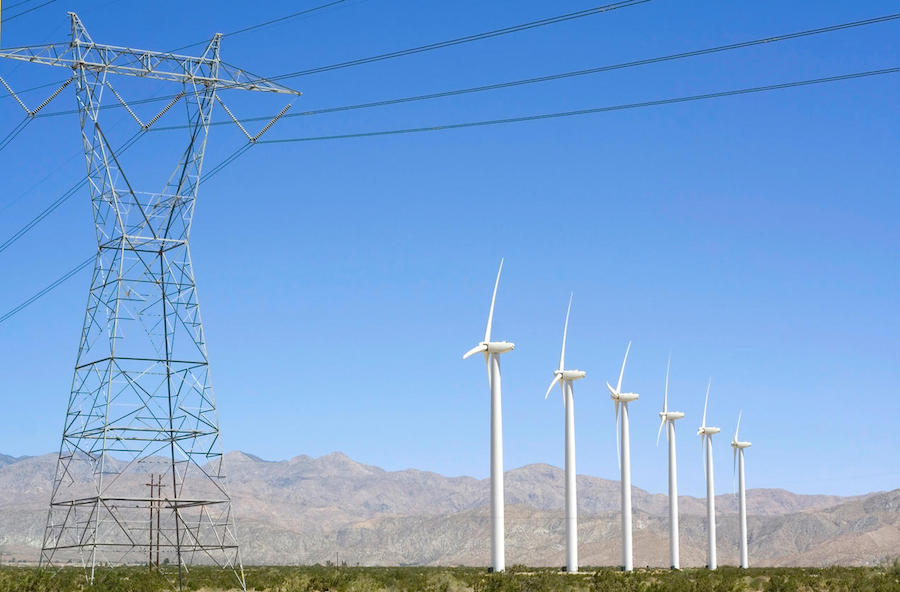The U.S. must more than double the recent historical pace of transmission construction to take full advantage of financial incentives and other provisions of the new climate change law, known as the Inflation Reduction Act (IRA), to cut greenhouse gas emissions, say Princeton University-led engineering researchers in a new report. However, current grid planning, siting, permitting and cost allocation realities could impede that outcome.
In its analysis, Princeton University's Zero-Carbon Energy Systems Research and Optimization Laboratory (ZERO Lab) says constrained growth of current U.S. transmission severely limits the expansion of renewable energy sources that the law, enacted in August, aims to propel. “Failing to accelerate transmission expansion beyond the recent historical pace of about 1% per year increases 2030 U.S. greenhouse emissions by about 800 million tons per year,” says lab leader, university engineering profesor Jesse Jenkins, adding that more than 80% of the potential IRA-promised emissions cuts by that year would be lost.
Researchers say transmission expansion must "reach an average of about 2.3% per year," to accommodate wind, solar and other projects under development that are aimed to "meet growing demand from electrification and reduce fossil fuel use in the power sector."
The US Energy Dept. on Oct. 3 announced it was seeking input in how the Defense Production Act (DPA) could bolster U.S. grid reliability, particularly in procuring transformers and other components such as solar photovoltaics, insulation materials, electrolyzers, platinum group metals and fuel cells for clean hydrogen.
"Supply chain challenges such as wait times for upwards of two years for grid transformers have coincided with an increase in climate-fueled disasters, such as hurricanes and wildfires, that threaten grid reliability," DOE said.
The agency said approaches could include "direct financial support to expand domestic manufacturing capacity for transformers or key material inputs, establishing domestic supply chains to manufacture next-generation transformers or a commitment to purchase a quantity of transformers to provide manufacturers with demand certainty."
DOE also says it plans to use $250 million in IRA funds to support investment under DPA in heat pump manufacturing and deployment. “The Defense Production Act provides us with a vital tool to make targeted investments ... essential to ensuring power grid reliability and achieving our clean energy future,” said Energy Secretary Jennifer M. Granholm.
DOE seeks response to its request for information by close of business on Nov. 30.
But observers say the question now is how to make expanded transmission construction a reality. “No one can credibly argue that we can timely make the changes to our energy infrastructure necessary to complete our transition to renewable energy without streamlining the permitting of energy infrastructure projects,” says Jeffrey Porter, an environmental attorney at Mintz, a Boston law firm.
Rob Gramlich, president of transmission consultant Grid Strategies LLC, says there are more than 1,000 gigawatts of proposed wind, solar and energy storage projects waiting to be connected to the grid before they can be built. “Transmission legislation would be very helpful. Our regulatory structure was set up for addressing 3,000 independent utilities, not for building the interstate highway type of power lines we need for clean energy,” he told ENR.
Andy Witmeier, director of resource utilization for the Midcontinent Independent System Operator (MISO), which managed transmission in all or part of 15 states and the Canadian province of Manitoba, said on Sept. 27 that it is experiencing exponential growth in project connection requests. “The current applications continue to be heavily weighted with renewables and standalone storage requests, again tripling the amount submitted in the previous year,” he said.
Gramlich credits MISO for its more proactive transmission planning, with the operator now seeking proposals for 18 transmission projects totaling $10.3 billion it approved in July that were identified through long range transmission planning.
'High Priority'
A proposal by Sen. Joe Manchin (D-W. Va) to streamline permitting of energy projects, particularly in transmission, included a two-year deadline for National Environmental Policy Act review of major projects and new Federal Energy Regulatory Commission authority to approve construction of long-range and interstate transmission lines needed to connect power users with clean sources in other parts of the country.
The proposal also was set to allow President Joe Biden to designate as "high-priority" some energy projects that meet certain criteria—enabling FERC to potentially override traditional state authority over approvals, use eminent domain authority to site them and streamline the legal challenge process.
In a letter to Senate Majority Leader Chuck Schumer (D-N.Y.) and Senate Minority Leader Mitch McConnell (R-Ky.) last month, the National Association of Regulatory Utility Commissioners termed the provisions an “overreach and infringement on state authority,” claiming the Manchin proposal “will serve only to centralize and consolidate federal authority ... without achieving the streamlining goals of alleviating delay in electric transmission siting process.”
Manchin was forced to pull the reform measure from a short-term spending bill last week to gain enough votes to pass that needed legislation, but it could be attached to other proposals before the end of the year, Gramlich says. Schumer already said in a statement that negotiations on a 2022 alternative solution are continuing.
Gramlich points to a pending FERC proposed strategy unveiled in May called Building for the Future Through Electric Regional Transmission Planning. He expects it to become final rule early next year, although there is no deadline.
'Wrong Direction'
But Howard Crystal, senior attorney at the Center for Biological Diversity, is concerned that in its proposal, FERC may expand the “right of first refusal” that would allow incumbent utilities to develop transmission projects without competition from merchant developers, in order to expedite work. He said the action is anti-competitive and “moving in the wrong direction.”
The US Justice Dept.and Federal Trade Commission said in comments that FERC transmission planning and cost allocation measures could be significant in addressing the logjam, but that "reforms can go further if [the agency] addresses the anticompetitive incentive and ability for incumbent transmission owners to influence transmission planning processes to favor projects over which they can maintain their monopolies.”
Justice and the Commission said entities with grid-wide perspectives can play an important role in regional and national expansion planning. “Transmission developers acting independently and approaching their work from a local perspective cannot be expected to plan efficiently integrated regional or interregional transmission networks,” they said.
“Planning needs to look more holistically,” Crystal says. His group urges FERC to “make the cost-effective transition to renewable energy the highest priority in the transmission planning reforms it adopts,” and to require grid operators to name an independent transmission planning monitor not tied to utilities."
The Energy Dept. also is looking at transmission holistically under the National Electric Transmission Congestion Study to consider designating "national interest" electric transmission corridors. The study is required by law every three years, but the last one issued is more than seven years old, Crystal says.
The Center for Biological Diversity filed a lawsuit against DOE for failing after a year to produce documents the group requested in July 2021 under the Freedom of Information Act to view agency actions to complete the study. “For well over a decade, Congress has made it clear that DOE must prepare triennial grid congestion studies to inform transmission planning,” the group told Energy Secretary Jennifer Granholm in a July 20 letter.
DOE’s draft study said it intended to develop and rely on a new approach to grid congestion analysis called the North American Energy Resilience Model to consider impacts on the grid of various energy sources—including fossil fuels—but it has not expanded on its details, Crystal says, adding that there are alternatives to consider when planning transmission, including distributed energy options.







Post a comment to this article
Report Abusive Comment